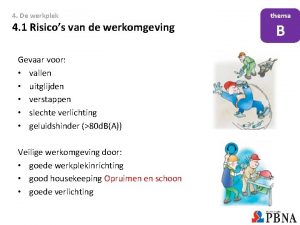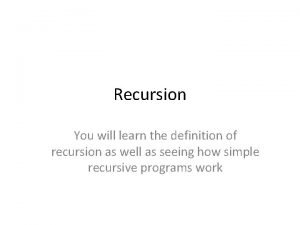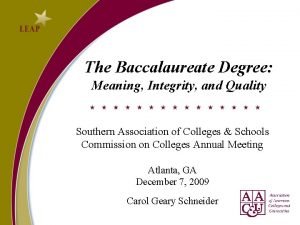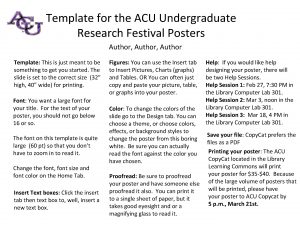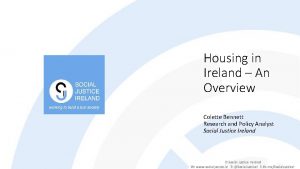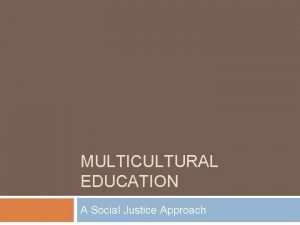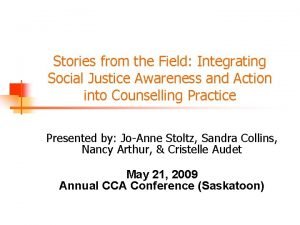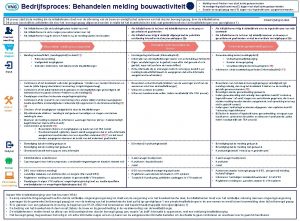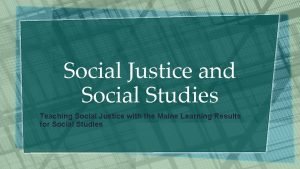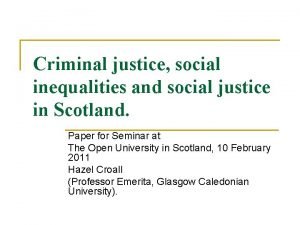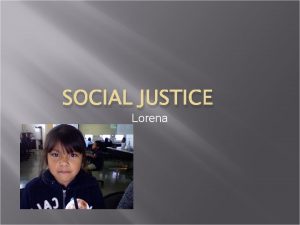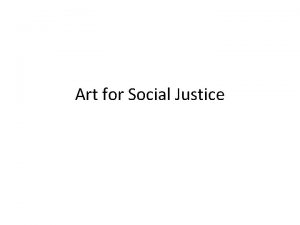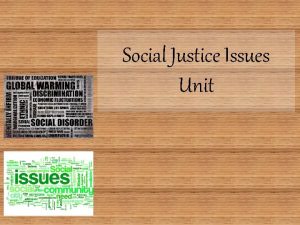MELDING DATA WITH SOCIAL JUSTICE IN UNDERGRADUATE STATISTICS

































- Slides: 33

MELDING DATA WITH SOCIAL JUSTICE IN UNDERGRADUATE STATISTICS AND DATA SCIENCE COURSES Silas Bergen Winona State University; Winona, MN, USA IASE Roundtable 2016 Berlin, Germany 1

SOCIAL JUSTICE “justice in terms of the distribution of wealth, opportunities, and privileges within a society. ”

Goals: 1. Promote growth in quantitative proficiency • Always using real, publicly-available data 2. Educate about social inequity 3. Foster reflection on learning… • …for both students and myself!

Introductory statistics: Project #1 1. Promote growth in quantitative proficiency • Graphical procedures • Chi-square test of association • Two-sample t-test • 95% Confidence intervals for differences in means and proportions 2. Educate about social inequity • Learn about the “Life-course framework” and structural racial inequity 3. Reflect on findings… • …through pre- and post- project questions 6

Introductory statistics: Project #1 • Life-course framework: Differences in protective and risk factors across race associated with differences in health outcomes • Protective/risk factors: • Nutrition • Social support • Income • Health care • Stress • Marital status • Health outcomes: • Infant birth weight • Infant gestational age Michael C. Lu, MD, MPH and Neal Halfon, MD, MPH, “Racial and Ethnic Disparities in Birth Outcomes: A Life-Course Perspective, ” Maternal and Child Health Journal 7, no. 1 (March 2003): 13– 30 http: //mchb. hrsa. gov/infantmortalitysummit/disparitieslifecourse. pdf 7

2 Parts A. Snapshot (cross-sectional) B. Historic (longitudinal) 8

Part A: Snapshot (cross-sectional) • Formal statistical tests (chi-square, 2 -sample t-test) to examine racial disparity across: o Employment status Data from American Community Survey using Data Ferrett o Income o Risk of having a low birth weight infant Data from North Carolina Vital Statistics Dataverse o Number of prenatal care visits 9

10

Part B: Historic (longitudinal) • Graphical procedures to examine changes over time in racial disparity across: o. Poverty Rate o. Median household income o. High-school completion rate o. Low birth weight rate o. Teenage childbearing rate o. Life expectancy at birth IPUMS data from Current Population Survey Annual Social and Economic Supplement Data from National Center for Health Statistics 11


4 Reflection Questions • 2 questions asked pre- and post- project • Taken from Pew Research article “King’s Dream Remains an Elusive Goal” • http: //pewrsr. ch/1 aorx 1 c • 2 questions asked post-project only 13

Question #1 (pre- and post-project) How much progress toward Martin Luther King’s dream of racial equality do you think the U. S. has made over the last 50 years? A lot Some A little None at all 14

Question #2 (pre- and post-project) How much more needs to be done in order to achieve racial equality? A lot Some A little None at all 15

Question #3 (post-project only) I am more informed about the nature of racial inequality having completed this project Strongly agree Agree Disagree Strongly disagree 16

Question #4 (post-project only) The nature of racial inequality seems more complex after completing the project Strongly agree Agree Disagree Strongly disagree 17

Question #1 (pre- and post-project) How much progress toward Martin Luther King’s dream of racial equality do you think the U. S. has made over the last 50 years? Post-project responses Pre-project None at all A little Some A lot responses None at all 0 0 A little 0 0 1 0 Some 0 5 14 1 A lot 0 1 7 9 • No change: 25 • “Pessimistic” change: 13 • “Optimistic” change: 2 18

Question #2 (pre- and post-project) How much more needs to be done in order to achieve racial equality? Post-project responses Pre-project None at all A little Some responses None at all 0 0 0 A little 0 0 4 Some 0 2 8 A lot 0 1 1 • • • A lot 1 0 8 13 No change: 21 “Pessimistic” change: 13 “Optimistic” change: 4 19

Question #3 (post-project only) I am more informed about the nature of racial inequality having completed this project 20

Question #4 (post-project only) The nature of racial inequality seems more complex after completing the project 21

Introductory statistics: Project #2 1. Promote growth in quantitative proficiency • Example of Fisher’s Exact Test 2. Educate about social inequity • Learn about the “School-to-prison pipeline” 3. Reflect on findings… • …through open-ended essay-type questions 22

Introductory statistics: Project #2 School-to-prison pipeline • Children pushed out of school more likely to end up in criminal justice system • Black children are more likely than white children to be disciplined with out-of-school suspensions 23

Introductory statistics: Project #2 • Data from U. S. Department of Education Office of Civil Rights o http: //ocrdata. ed. gov • Suspension status for all black and white students at Winona Senior High School 24

Introductory statistics: Project #2 25

Introductory statistics: Project #2 1. Write 3 -4 sentences summarizing your findings, as if you were reporting them to a WSHS administrator or at a parent-teacher meeting. What “action steps” might you recommend to school administrators and teachers as a result of your findings? 2. What do you think about using suspension as a method of disciplining bad behavior? 26

Project 3: State expenditure on developmentally disabled Californians 27

Project #2 1. Promote growth in quantitative proficiency • Importance of the “third variable” 2. Educate about social inequity • Discrimination is not always what it seems 3. Reflect on findings… • …through one “synthesis paragraph” 28

29

30

31

32

Write a paragraph clearly summarizing your “big picture” findings, and stating whether you believe these data provide evidence of discrimination. If you think there is discrimination, describe the nature of the discrimination. If you do not, clearly explain why not.

Future work • Move from the “what” to the “why”, i. e. WHY DOES THE OBSERVED INEQUITY EXIST? • Lesser (2007): “…. social justice, however, does not necessarily require or guarantee equal outcomes”. Are inequities due to… • Confounding factors? • Systemic discrimination? • Help students to reflect on the “what’s next”/ “so what” • Attempt to better understand how student definitions of “racial inequity” change as a result of quantitative treatment of racial inequity across an entire course • Change pre-/post-project approach to pre-/post-course? 34

THANK YOU!!
 Software project management notes
Software project management notes Vhf kurs
Vhf kurs Project planning begins with the melding of
Project planning begins with the melding of Whist meldinger
Whist meldinger Koolmonoxide
Koolmonoxide Cosmos meaninh
Cosmos meaninh Portland state university tuition
Portland state university tuition Uci ics academic advising
Uci ics academic advising Seoul university acceptance rate
Seoul university acceptance rate Definition of undergraduate student
Definition of undergraduate student Undergraduate research conference nyu
Undergraduate research conference nyu Difference between postgraduate and undergraduate
Difference between postgraduate and undergraduate Difference between postgraduate and undergraduate
Difference between postgraduate and undergraduate Cornell nbb
Cornell nbb Los angeles city college
Los angeles city college Acadia university undergraduate programs
Acadia university undergraduate programs University of southern california
University of southern california Dean of undergraduate studies fsu
Dean of undergraduate studies fsu Csub orientation
Csub orientation What is an undergraduate degree
What is an undergraduate degree Acu undergraduate research festival
Acu undergraduate research festival Temple university undergraduate bulletin
Temple university undergraduate bulletin Acu undergraduate
Acu undergraduate Usc neuroscience
Usc neuroscience King's undergraduate research fellowship
King's undergraduate research fellowship Unb undergraduate calendar
Unb undergraduate calendar Ncsu undergraduate research symposium
Ncsu undergraduate research symposium Introduction to statistics what is statistics
Introduction to statistics what is statistics Colette bennett social justice ireland
Colette bennett social justice ireland Immigrant definiton
Immigrant definiton Social justice approach
Social justice approach Health promotion initiatives pdhpe
Health promotion initiatives pdhpe Types of social justice
Types of social justice Social justice essential questions
Social justice essential questions




